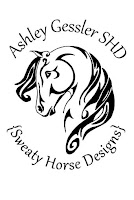A picture is so much more than pixels and resolutions. It's the story that the image tells, the way the viewer's eye is guided through the image, the colors, the balance within the portrait, the use of space... and when you wrap all of those elements together it gives you a photograph that goes beyond just being a picture.
Once you've discovered the style of photography that speaks to you (http://sweatyhorsedesigns.blogspot.com/2015/06/whats-your-style-and-how-to-find-it.html) and are more aware of what's in the background behind your subject (http://sweatyhorsedesigns.blogspot.com/2015/06/whats-up-with-other-peoples-photos.html), you are ready to start learning about balance and how it can greatly improve your picture-taking skills as well as seriously impress your friends!
For the traditional portrait, the photographer makes a valiant attempt to place the camera at head-height with the subject, lines him/her up in the center of the image, and clicks away. That's all fine and dandy. But, what if you want a more artsy feel? What if you glance back at the picture you just took and feel as if something is missing?
Visualizing your image in "thirds" can give a more dramatic
effect than always centering your subject in the frame.
Enter the "Rule of Thirds."
Every good image has a balance to it; a visual weight that moves the viewer's eye and gives them a sense of being in the picture. (For more in-depth reading on what balance is and what it can do, read https://www.nyfa.edu/student-resources/five-kinds-photography-balance-you-need-to-understand/ and for a visual journey through balance, read http://photoinf.com/General/KODAK/guidelines_for_better_photographic_composition_balance.html)
The Rule of Thirds is one of my favorite tools to give my photos a different feel. Line your subject up with one of the "third" balance lines, but be careful not to get your subject so close to the edge of the image that they look like they are about to fall out of the photo.
This picture is off balance by itself and it almost feels like my daughter
will fall out of the right side, however adding some text corrects the issue.
This photo would be unbalanced if it was displayed without the text.
Another use of the Rule of Thirds is to convey a sense of motion in a still image. For action shots, I generally like to put my extra space in the direction of the motion (aka what the subject is running toward or looking at).

Use the Rule of Thirds to give your still photos a sense of motion. Place the extra "space" in the direction of the action or in the direction your subject is looking.
The next tip is to give a sense of direction to your image. What were you doing that day? Was your child showing you something interesting? Tell the story with your camera. Have your child point at whatever they are looking at or hold up their "interesting object" toward the camera so you can take a picture of it with your child's face in the background. Two birds with one stone!
Remember this example from the first post? (http://sweatyhorsedesigns.blogspot.com/2015/06/whats-up-with-other-peoples-photos.html)
These pictures are absolutely terrible, but you get the gist.
LEFT: It's just a picture of the back of my daughter's head.
RIGHT: I asked her to point at what she was looking at and ta-da! There are elephants in
the background. Who knew!? I should have had her move her hand more to the right
for the sake of the photo, but she was not interested in appeasing me right at this moment.
This Mommy is far too demanding when it comes to picture-taking.
Giving a sense of motion, such as using the Rule of Thirds to convey action, or asking your child to point at what he/she is looking at, can bring extra life into your photos. Sometimes, the photo can tell the entire story without the need for captions or an explanation.
*TIP*: Give your photos a sense of motion by having your child point at whatever they are looking at, using the Rule of Thirds to convey a sense of motion, or giving your images an artistic balance to them.
 |
| Please visit my website www.AshleyGesslerSHD.com |






No comments:
Post a Comment